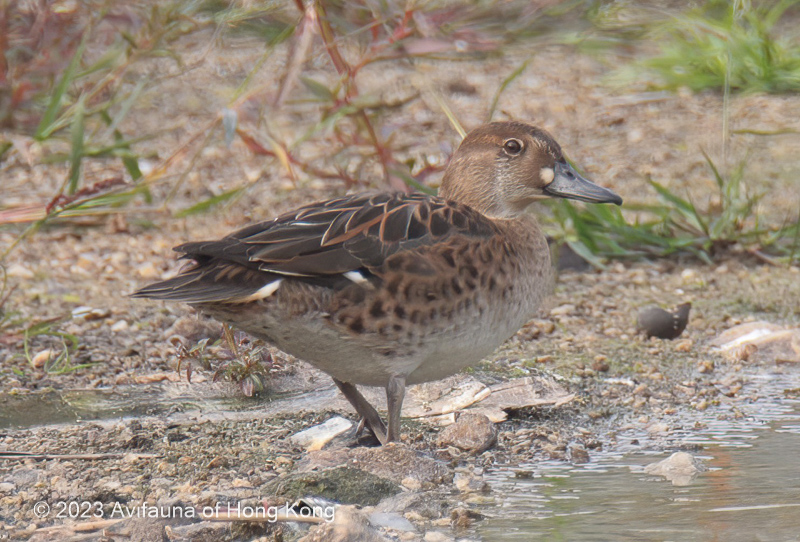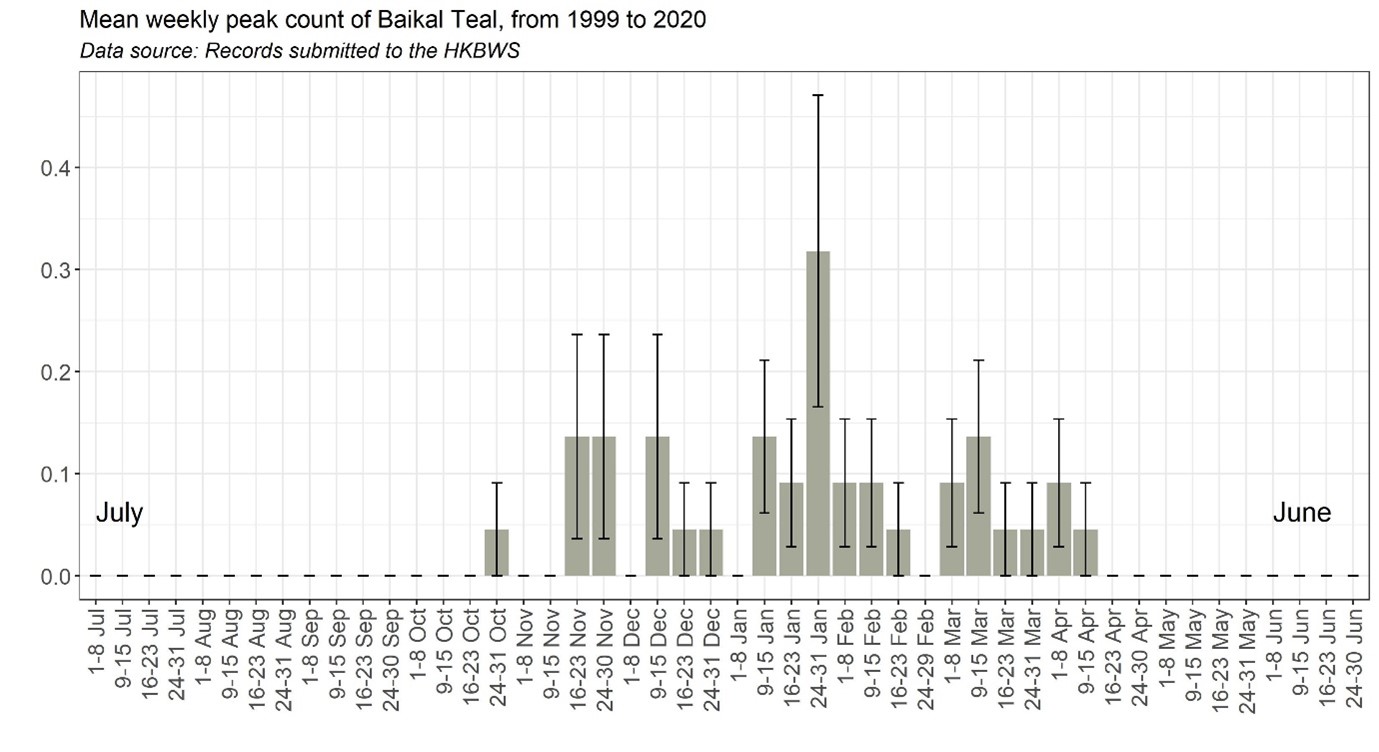Baikal Teal Sibirionetta formosa 花臉鴨
Category I. Scarce winter visitor to Deep Bay area wetlands.
IDENTIFICATION

Feb. 2022, Michelle and Peter Wong.
39-43 cm. Larger than Eurasian Teal with a slightly more angular head profile. Male in breeding plumage has very distinctive face pattern comprising yellow, green, black and white, distinct black spots on a pinkish chest and long scapulars of chestnut, black, white and buff.

Dec. 2008, John and Jemi Holmes.
Compared to both Eurasian Teal and Garganey, females have a well-marked face pattern that usually includes both an obvious (and sometimes dark-bordered) white spot at the base of the bill and a white throat that extends some way up behind the cheek. In flight has greyish forewing, white tips to secondaries and orange-buff upper border to speculum, the latter more obvious on the male.
VOCALISATIONS
There are no reports of this species vocalising in HK. The following is a recording of a male on the breeding grounds.
DISTRIBUTION & HABITAT PREFERENCE
Most records have been on gei wai or fish ponds, with a few in the intertidal areas of Deep Bay. The exceptions are a female at Wah Fu on 27 December 1985, a male in Kowloon Park on 20 December 1992 and 13 February 1993 (the origins of this bird are, however, suspect), an adult female or eclipse male at Kam Tin on 18 November 1995 and a female at Long Valley on 23 January 2016.
OCCURRENCE
One to four birds have been recorded in most winters since the first substantiated record of one from 8 January to 18 March 1984, though only ones or twos have been recorded this century; the peak count is three females on 1 March 1986, during which winter five individuals were recorded. Extreme dates are 31 October 1999 and 11 April 1999, while the main period of occurrence is from mid-November to mid-March (Figure 1). Although the data suggest that numbers are on average slightly higher since 1999, it is quite possible this is simply a reflection of observer activity. The scarcity of this species in HK suggests that few winter this far south in China.
The first report of this species in HK was that of Dove and Goodhart (1955) who stated one was shot out of three seen at Yuen Long on or about 1 October 1953. This lies outside the period of occurrence noted since then. Macfarlane and Macdonald (1966) reported a male shot at Mai Po on 8 February 1961. La Touche (1931-34) stated that Baikal Teal appeared ‘in South-East China in large numbers during winter’ which contrasts markedly with contemporary data, though it is possible that HK lay outside the area that La Touche regarded as belonging to southeast China.
BEHAVIOUR, FORAGING & DIET
No information.
RANGE & SYSTEMATICS
Monotypic. Breeds in east Siberia from the Yenisei valley to Kamchatka and the Sea of Okhotsk. Winters mainly in Japan, South Korea and mainland China, though it is rare in the southern coastal provinces and Taiwan. (Carboneras and Kirwan 2020, Liu and Chen 2020).
CONSERVATION STATUS
IUCN: Least Concern. Population trend increasing.
Figure 1.

Carboneras, C. and G. M. Kirwan (2020). Baikal Teal (Sibirionetta formosa), version 1.0. In Birds of the World (J. del Hoyo, A. Elliott, J. Sargatal, D. A. Christie, and E. de Juana, Editors). Cornell Lab of Ornithology, Ithaca, NY, USA. https://doi.org/10.2173/bow.baitea.01.
Dove, R. S. and H. J. Goodhart (1955). Field observations from the Colony of Hong Kong. Ibis 97: 311-340.
La Touche, J. D. D. (1931-34). Handbook of the birds of Eastern China Vol. 2. Taylor and Francis, London.
Macfarlane, A. M. and A. D. Macdonald, revised by Caunter, J. R. L. and A. M. Macfarlane (1966). An Annotated Check-list of the Birds of Hong Kong. Hong Kong Bird Watching Society, Hong Kong.
Liu, Y. and Y. H. Chen (2020). The CNG Field Guide to the Birds of China (in Chinese). Hunan Science and Technology Publication House, Changsha.

